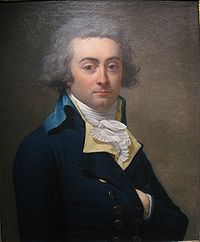- Marie-Jean Hérault de Séchelles
-
Marie-Jean Hérault de Séchelles (September 20, 1759 – April 5, 1794) was a French judge and politician who took part in the French Revolution.
Contents
Origins and early career
Marie-Jean Hérault de Séchelles was born in Paris in a noble and well-known family. His grandfather was René Hérault, who had served as Lieutenant General of Police of Paris between 1725 and 1739. His great-grandfather was Jean Moreau de Séchelles (1690-1760), who had served as Controller-General of Finances between 1754 and 1756 and had given his name to the Seychelles archipelago. Jean Moreau de Séchelles's daughter, Hélène Moreau de Séchelles (1715-1798), was the second wife of René Hérault.
Most authors, however, consider that René Hérault was not the biological grandfather of Marie-Jean Hérault de Séchelles. His biological grandfather was most likely Louis Georges Érasme de Contades (1704-1793), Marshal of France, who had an affair with Hélène Moreau de Séchelles during her marriage to René Hérault. Hélène Moreau de Séchelles gave birth to a son in 1737, Jean-Baptiste Martin Hérault de Séchelles - the father of Marie-Jean, who died in 1759, at the Battle of Minden, where Contades was commanding the French army. Contades took care of Marie-Jean Hérault de Séchelles after the early death of his father. He had arranged to marry his illegitimate son Jean-Baptiste Martin Hérault de Séchelles to his wife's niece, so that he might present himself in society as the "uncle" of Marie-Jean.
Marie-Jean Hérault de Séchelles was also the first cousin of the famous Duchess of Polignac, the friend and confidant of Queen Marie Antoinette. The Duchess of Polignac, who would later be the object of deep revolutionary disapprobation, was the daughter of Jeanne Charlotte Hérault (1726-1753 or 1756), herself the daughter of René Hérault and his first wife. Finally, he was also the nephew of Claude-Henri Feydeau de Marville, Lieutenant General of Police of Paris between 1739 and 1747, who had married Marie-Jean's aunt - the second daughter of René Hérault and his first wife.
Hérault de Séchelles made his debut as a lawyer at the Châtelet of Paris, the city's civil and criminal court. At the age of twenty, he became King's Advocate (a position similar to Advocate General) at the Châtelet, in part due to the aid of the Duchess of Polignac. Associates of the Polignac family presented him to the queen, who pushed his appointment as Advocate General at the prestigious Parlement of Paris.
His legal occupation did not prevent him from devoting himself to literature, and in 1785 he published an account of a visit he had made to the noted naturalist Georges-Louis Leclerc, the Comte de Buffon at Montbard: La visite à Buffon, ou Voyage à Montbard. He was also the author of a philosophical work published after his death, Théorie de l'ambition.
Despite his upbringing, Hérault became an early proponent of Revolutionary ideas, and took part in the storming of the Bastille in July 1789. On December 8, 1789, he was appointed judge of the court of the Ier arrondissement in the département of Paris. From the end of January to April 1791, Hérault was absent on a mission in Alsace, where he had been sent to restore order following a period of civil unrest. On his return he was appointed Commissaire du Roi in the Cour de cassation.
Legislative Assembly and initial missions
He was elected as a deputy for Paris to the Legislative Assembly, where he gravitated towards the extreme left. He also served as a member of several committees; during his time as a member of the diplomatic committee, in June 1793, he presented a memorable report demanding that the nation should be declared to be in danger.
During and after the August 10 insurrection of 1792, he worked alongside Georges Danton, one of the organizers and leading figures of this rising, and, on September 2, was appointed president of the Legislative Assembly.
In 1792, he was elected to the National Convention as deputy for the département of Seine-et-Oise, and was sent on a mission to organize the new département of Mont Blanc. He was thus absent during the trial of King Louis XVI, but he made it known that he approved of his execution.
1793-1794
On his return to Paris, Hérault was several times president of the Convention, notably on June 2, 1793, the occasion of the attack on the Girondins (when he unsuccessfully pleaded for the troops to retreat), and on August 10, 1793, on which was celebrated the passing of the Acte constitutionnel (called "of The Mountain"); Hérault de Sechelles served, alongside Louis de Saint-Just, as one of the writers and redactors of the 1793 Constitution, which was fated never to be applied.
As a member of the Reign of Terror's Committee of Public Safety, Hérault was chiefly concerned with diplomacy, and from October to December 1793 was employed on a diplomatic and military mission in Alsace. This mission made him an object of suspicion to the other members of the Committee, especially to Maximilien Robespierre, who as a deist and a follower of the ideas of Jean-Jacques Rousseau, resented Hérault and other followers of Denis Diderot's naturalism. Hérault, whose aristocratic background was also accounted a source of suspicion, was accused of treason. He was tried before the Revolutionary Tribunal and condemned alongside Danton, François Joseph Westermann, Camille Desmoulins, and Pierre Philippeaux. They were guillotined on the same day: April 5, 1794 (16th Germinal in the year II).
Fictionalized Accounts
- Hérault appears in an important supporting role in A Far Better Rest, a reimagining of A Tale of Two Cities, by Susanne Alleyn.
References
 This article incorporates text from a publication now in the public domain: Chisholm, Hugh, ed (1911). Encyclopædia Britannica (11th ed.). Cambridge University Press. In turn, it gives the following references:
This article incorporates text from a publication now in the public domain: Chisholm, Hugh, ed (1911). Encyclopædia Britannica (11th ed.). Cambridge University Press. In turn, it gives the following references:- Voyage a Montbard, published by F.A. Aulard (Paris, 1890).
- F.A. Aulard, Les Orateurs de la Legislative el de la Convention, 2nd ed. (Paris, 1906).
- J Claretie, Camille Desmoulins, Étude sur les Dantonistes (Paris, 1875).
- Dr Robinet, Le Procés des Dantonistes (Paris, 1879).
- "Hérault de Séchelles, sa premiere mission en Alsace" in the review La Revolution Française, tome 22.
- Ernest Daudet, Le Roman d'un conventionnel. Hérault de Séchelles et les dames de Bellegarde (904).
- Hérault de Séchelles, ed. E. Dard, Œuvres littéraires (Paris, 1907).
Categories:- 1759 births
- 1794 deaths
- People from Paris
- French Legislative Assembly deputies
- Deputies to the French National Convention
- French judges
- French jurists
- French nobility
- People executed by guillotine during the French Revolution
- Executed French people
- People executed by decapitation
Wikimedia Foundation. 2010.


